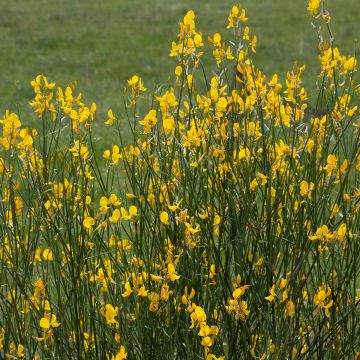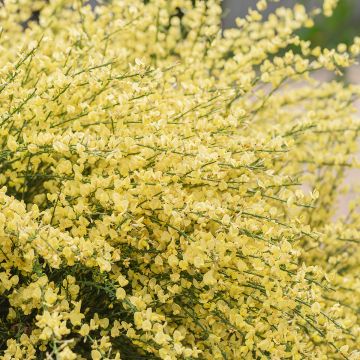

Cytisus procumbens Zeelandia


Cytisus procumbens Zeelandia
View more pictures
Hide images

Barbara C.

I have 2 of them, they are really beautiful.
Barbara C. • 60 FR

Barbara C.

Beginning of flowering, superb.
Barbara C. • 60 FR

Coralie B.

April 2018, first flowering
Coralie B. • 04 FR
Cytisus procumbens Zeelandia
Cytisus procumbens Zeelandia
Broom
A young plant that seemed fragile upon arrival but reached 1.5 meters in less than two years and became very vigorous. Very beautiful flowers.
Delphine, 07/09/2025
Special offer!
Receive a €20 voucher for any order over €90 (excluding delivery costs, credit notes, and plastic-free options)!
1- Add your favorite plants to your cart.
2- Once you have reached €90, confirm your order (you can even choose the delivery date!).
3- As soon as your order is shipped, you will receive an email containing your voucher code, valid for 3 months (90 days).
Your voucher is unique and can only be used once, for any order with a minimum value of €20, excluding delivery costs.
Can be combined with other current offers, non-divisible and non-refundable.
Home or relay delivery (depending on size and destination)
Schedule delivery date,
and select date in basket
This plant carries a 24 months recovery warranty
More information
We guarantee the quality of our plants for a full growing cycle, and will replace at our expense any plant that fails to recover under normal climatic and planting conditions.

Would this plant suit my garden?
Set up your Plantfit profile →
Description
The Cytisus procumbens 'Zeelandia' is a variety of hybrid broom that is particularly floriferous, forming a flexible mass covered in lilac pink and cream flowers in spring. It is a modest-sized bush with slender arched green branches, whose tiny deciduous leaves fall early, before summer. Its fragrant, massive flowering attracts many pollinating insects. This variety works wonders on a slope, in a large rockery, or in a border.
The 'Zeelandia' Cytisus belongs to the large family of Fabaceae. It is a horticultural creation resulting from the cross-breeding between Cytisus (x) praecox and Cytisus (x) dallimorei 'Burkwoodii'. The Cytisus (x) praecox itself is a hybrid obtained by cross-breeding Cytisus multiflorus and C. purgans. It is a very hardy bush with very rapid growth, but with a short lifespan, which prefers fairly poor, sandy soils that are neutral to acidic. Its resistance to drought is good once it is well-rooted.
This early 'Zeelandia' broom, with a size of 1.50m (4.92 ft) in all directions, develops a bushy, dense habit, but with a light appearance due to its slender stems and very small trifoliate leaves that are discreet and few in number. The flexible, arched stems retain their green colour throughout the year, even in winter. The ephemeral, simple, alternate, narrow leaves, 5 to 10mm (0.2 to 0.4 in) in length fall rapidly in spring. The flowering takes place in April-May, depending on the region. A multitude of well-fragrant pea-like flowers, 1 to 2cm (0.39 to 0.78 in) in length, grouped towards the upper part of the branches, submerge the vegetation. The colour of the flowers evolves as they open: lilac pink dominates at blooming, then the flowers open to reveal shades of mauve and pale yellow to cream white. They are followed by the formation of small black pod-shaped fruits. Be careful when the pods fall as they can stain, lightly prune the bush after flowering. The lifespan of this plant is quite short, around 5 to 8 years.
Undemanding and drought-tolerant, the Cytisus (x) praecox 'Zeelandia' is an excellent sun-loving bush that thrives in well-drained to dry soil. Severe pruning after flowering is preferable to avoid fruiting, which quickly exhausts the plant. This also helps to maintain a compact habit that does not become bare at the base. In spring, the spectacle of its abundance of flowers and the fragrance they emit in calm weather is a marvel. Place it at the corner of the house, on a large slope, or in a large shrub border serving as a focal point in the centre of a small garden. It can be associated with many shrubs with foliage or spring flowering or summer flowering: other broom with white or pink flowers, abelias, a small white spirea or a Berberis Harlequin with pink foliage, for example. Also consider Nepetas and perennial geraniums to accompany it naturally.
Report an error about the product description
Cytisus procumbens Zeelandia in pictures




Plant habit
Flowering
Foliage
Botanical data
Cytisus
procumbens
Zeelandia
Fabaceae
Broom
Cytisus x boskoopii 'Zeelandia'
Cultivar or hybrid
Other Broom - Cytisus
View all →Planting and care
Cytisus procumbens 'Zeelandia' should be planted in spring or autumn in any light and well-drained soil, preferably slightly acidic, in a sunny position. It tolerates limestone. Choose its location carefully, as it does not like to be moved. Not very demanding, severe pruning after flowering is preferable, to avoid fruiting, which quickly exhausts the plant. This also helps to maintain a compact habit that does not become bare at the base. In case of severe winter, cut back the blackened stems to the base. Its lifespan is quite short, around 5 years.
Planting period
Intended location
Care
-
, onOrder confirmed
Reply from on Promesse de fleurs
Similar products
Haven't found what you were looking for?
Hardiness is the lowest winter temperature a plant can endure without suffering serious damage or even dying. However, hardiness is affected by location (a sheltered area, such as a patio), protection (winter cover) and soil type (hardiness is improved by well-drained soil).

Photo Sharing Terms & Conditions
In order to encourage gardeners to interact and share their experiences, Promesse de fleurs offers various media enabling content to be uploaded onto its Site - in particular via the ‘Photo sharing’ module.
The User agrees to refrain from:
- Posting any content that is illegal, prejudicial, insulting, racist, inciteful to hatred, revisionist, contrary to public decency, that infringes on privacy or on the privacy rights of third parties, in particular the publicity rights of persons and goods, intellectual property rights, or the right to privacy.
- Submitting content on behalf of a third party;
- Impersonate the identity of a third party and/or publish any personal information about a third party;
In general, the User undertakes to refrain from any unethical behaviour.
All Content (in particular text, comments, files, images, photos, videos, creative works, etc.), which may be subject to property or intellectual property rights, image or other private rights, shall remain the property of the User, subject to the limited rights granted by the terms of the licence granted by Promesse de fleurs as stated below. Users are at liberty to publish or not to publish such Content on the Site, notably via the ‘Photo Sharing’ facility, and accept that this Content shall be made public and freely accessible, notably on the Internet.
Users further acknowledge, undertake to have ,and guarantee that they hold all necessary rights and permissions to publish such material on the Site, in particular with regard to the legislation in force pertaining to any privacy, property, intellectual property, image, or contractual rights, or rights of any other nature. By publishing such Content on the Site, Users acknowledge accepting full liability as publishers of the Content within the meaning of the law, and grant Promesse de fleurs, free of charge, an inclusive, worldwide licence for the said Content for the entire duration of its publication, including all reproduction, representation, up/downloading, displaying, performing, transmission, and storage rights.
Users also grant permission for their name to be linked to the Content and accept that this link may not always be made available.
By engaging in posting material, Users consent to their Content becoming automatically accessible on the Internet, in particular on other sites and/or blogs and/or web pages of the Promesse de fleurs site, including in particular social pages and the Promesse de fleurs catalogue.
Users may secure the removal of entrusted content free of charge by issuing a simple request via our contact form.
The flowering period indicated on our website applies to countries and regions located in USDA zone 8 (France, the United Kingdom, Ireland, the Netherlands, etc.)
It will vary according to where you live:
- In zones 9 to 10 (Italy, Spain, Greece, etc.), flowering will occur about 2 to 4 weeks earlier.
- In zones 6 to 7 (Germany, Poland, Slovenia, and lower mountainous regions), flowering will be delayed by 2 to 3 weeks.
- In zone 5 (Central Europe, Scandinavia), blooming will be delayed by 3 to 5 weeks.
In temperate climates, pruning of spring-flowering shrubs (forsythia, spireas, etc.) should be done just after flowering.
Pruning of summer-flowering shrubs (Indian Lilac, Perovskia, etc.) can be done in winter or spring.
In cold regions as well as with frost-sensitive plants, avoid pruning too early when severe frosts may still occur.
The planting period indicated on our website applies to countries and regions located in USDA zone 8 (France, United Kingdom, Ireland, Netherlands).
It will vary according to where you live:
- In Mediterranean zones (Marseille, Madrid, Milan, etc.), autumn and winter are the best planting periods.
- In continental zones (Strasbourg, Munich, Vienna, etc.), delay planting by 2 to 3 weeks in spring and bring it forward by 2 to 4 weeks in autumn.
- In mountainous regions (the Alps, Pyrenees, Carpathians, etc.), it is best to plant in late spring (May-June) or late summer (August-September).
The harvesting period indicated on our website applies to countries and regions in USDA zone 8 (France, England, Ireland, the Netherlands).
In colder areas (Scandinavia, Poland, Austria...) fruit and vegetable harvests are likely to be delayed by 3-4 weeks.
In warmer areas (Italy, Spain, Greece, etc.), harvesting will probably take place earlier, depending on weather conditions.
The sowing periods indicated on our website apply to countries and regions within USDA Zone 8 (France, UK, Ireland, Netherlands).
In colder areas (Scandinavia, Poland, Austria...), delay any outdoor sowing by 3-4 weeks, or sow under glass.
In warmer climes (Italy, Spain, Greece, etc.), bring outdoor sowing forward by a few weeks.


















































